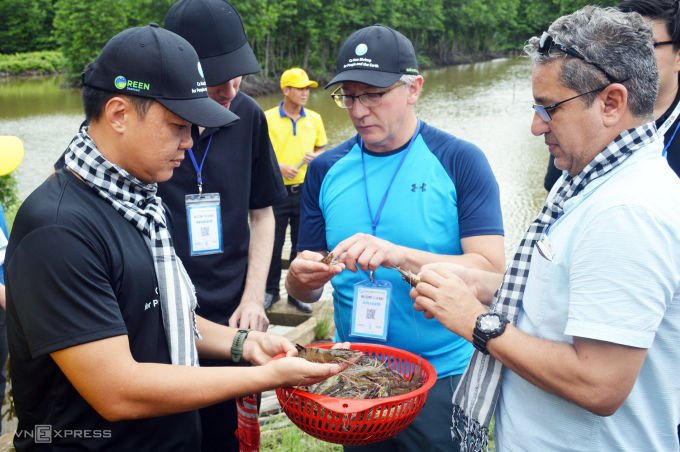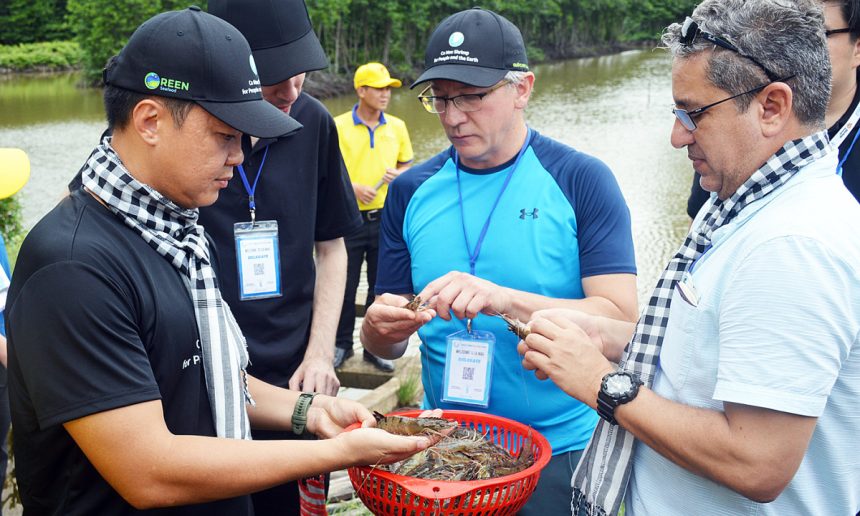Thousands of households in Ca Mau raise organic shrimp under the canopy of mangrove forests certified according to international standards, serving export and stable income.
Mr. Ung Van Dien, 46 years old in Rach Goc town, Ngoc Hien district, is one of the successful organic shrimp farming households supported by the business. With 6 hectares of shrimp raised under the canopy of mangrove forests, he earns a profit of more than 400 million VND per year. “In addition to shrimp, I also raise crabs and some fish species,” Mr. Dien said, saying that thanks to that, farmers have a more stable income.
In the past, most shrimp seeds came from the wild and people kept them and raised them. Later, when shrimp farming developed strongly, water quality was no longer stable, and the amount of natural breeds gradually decreased, so farmers had to buy more artificial breeds for cultivation, but still kept the traditional production method. Around the farming square, farmers keep mangrove trees such as mangroves, tigers, parrots, most commonly mangrove trees. Mangrove roots create shelter areas for shrimp and other aquatic species.

Mr. Ung Van Dien harvests shrimp raised under the canopy of the mangrove forest. Image: An Minh
“Foliage reduces water temperature, mangrove leaves fall and decompose, which is the main food source for shrimp,” Mr. Dien said, adding that shrimp raised for 4-6 months will be harvested gradually. When mature, according to shrimp behavior, they will move to the sea. At this time, during the two high tides of each month, farmers will drain the water and use nets to block the sluice gates to harvest seafood.
Nearly 30 km away, Mr. Bui Van Si, 65 years old in Vien An Dong commune, has spent nearly 40 years under the canopy of mangrove forests, said he has spent nearly 10 years raising environmentally friendly shrimp. Nearly 7 hectares of shrimp farms under the canopy of mangrove forests are being supported by businesses with 500,000 VND per hectare to invest in seed and cultivate organic shrimp according to export standards. Raw shrimp will be consumed by the company.
Thanks to access to technical advances, he nursed shrimp seeds to raise them before releasing them into the wild. Although it takes a lot of care, this is a way for shrimp to increase their survival rate, bringing more stable income to the family. Mr. Si has a profit of nearly 500 million VND per year, about 30% higher than the traditional way.
The ecological shrimp farming model was formed and developed in the southernmost province of the country before 2000. When the quality of the province’s organic shrimp was highly appreciated by the market, many seafood processing enterprises coordinated with other seafood processing enterprises. Forest management units invest and build shrimp farming areas according to international ecological and organic certification, the most popular is shrimp farming under the forest canopy.
Currently, Ca Mau has nearly 40,000 hectares of ecological shrimp farming under forest canopy, most concentrated in Ngoc Hien district with nearly 23,000 hectares. Of which, about 20,000 hectares of shrimp area are certified according to international standards.

A group of experts and buyers from other countries visited the shrimp farming model under the forest canopy in Ngoc Hien district. Image: An Minh
According to Mr. Le Dinh Huynh, General Secretary of the Vietnam Clean and Sustainable Shrimp Alliance, ecological shrimp farming is a form similar to natural farming, but must ensure the selection of breeds, farming environment, and water quality. . At the same time, during the farming process, farmers must comply with strict regulations according to quality standards certified by an experienced and reputable third party. Thanks to that, the output, quality and selling price of organic shrimp are higher and more stable than naturally raised shrimp.
The alliance and businesses are creating conditions for people to access international shrimp standards, as well as meet the taste for sustainable shrimp products in the country. From here, the parties participate in the ecological shrimp value chain, from seed production, farming, purchasing to processing and consumption.
Mr. Phan Hoang Vu, Director of the Department of Agriculture and Rural Development of Ca Mau province, said that aquaculture under the forest canopy is a form of farming associated with forest protection with many species such as shrimp, fish, crabs, and blood cockles. , wool snails,… Today, this model is also considered a measure to absorb carbon, reduce greenhouse emissions, in line with the green development trend in the world, bringing stable income to people. receive contracts.
Ca Mau is the only province in the country that borders the sea on three sides, with favorable conditions for developing aquaculture. The locality has the largest shrimp farming area in the country with nearly 280,000 hectares. The province strives to maintain brackish water shrimp farming area by 2025, total output reaching 280,000 tons, export value reaching 1.4 billion USD.
Cheers Ly



